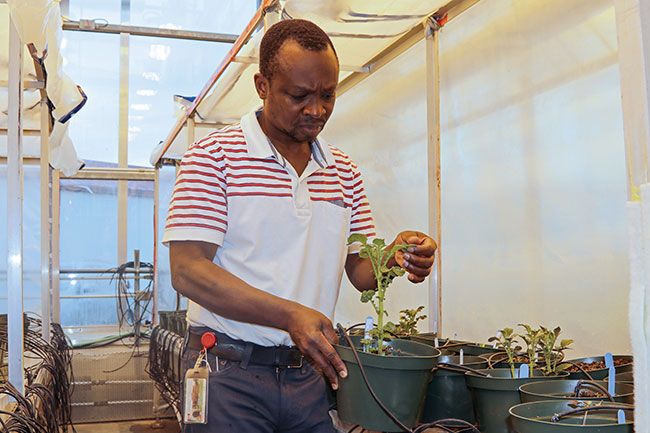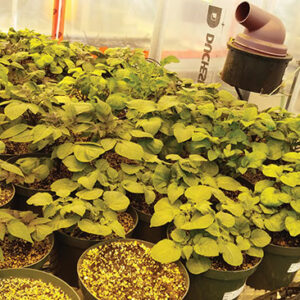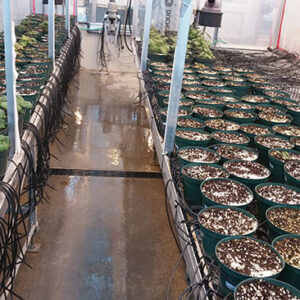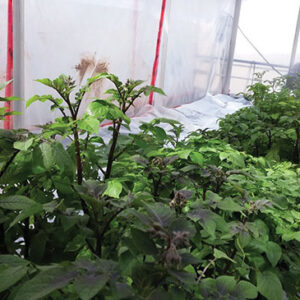
Features
Diseases
Selenium: new hope for late blight control
Antioxidant can help boost plant immunity.
March 18, 2024 By Julienne Isaacs
 Bourlaye Fofana is a research scientist at the Charlottetown Research and Development Centre.
Bourlaye Fofana is a research scientist at the Charlottetown Research and Development Centre. A plant immunity booster called selenium might be a “shot in the arm” for Canadian potato producers hoping to mitigate the effects of late blight.
Selenium is a mineral that is naturally present in soils. In high doses, it’s toxic, but in low doses, it’s an essential trace element for humans and animals.
Some soils are richer in selenium than others. Atlantic Canadian soils, for example, are low in selenium, says Bourlaye Fofana, a research scientist at Agriculture and Agri-Food Canada’s Charlottetown Research and Development Centre. Across Canada, there’s a kind of “gradation” of selenium in soils from east to west, with richer soils in B.C. and diminished selenium in the Maritime provinces.
Fofana works in plant physiology and genetics in potatoes and flax. “Everything I do is related to crop quality and improvement,” he says.
When Fofana first arrived at AAFC Charlottetown in 2008, he began to look at how soil mineral composition affected crop nutritional quality. What would happen, he asked, if he added a selenium treatment to seeds including flax, wheat, soybean and potato before planting? Would it boost the selenium content of the crop? And would that selenium be bioavailable to people eating the crop products?
When Fofana and his colleagues’ results were positive, the research continued. “We wanted to address how selenium would counteract bacteria contributing to potato seed decay,” says Fofana. “So, we were trying at that time to apply selenium solution on seed tubers in-furrow in hopes that bacteria would be reduced.”
But the researchers did not see a significant difference between seed-treated and non-treated for seed germination.
The researchers opted to repeat the experiment in the greenhouse. Again, they didn’t find tangible significant differences in germination.
They then decided to follow this experiment with a study on late blight by looking at the effects of selenium applied as seed treatment before planting and as a foliar application after late blight inoculation, or as a foliar application only. “We found that foliar application alone was as effective as combining seed treatment and foliar application,” says Fofana.
“The data suggest that [selenium] acts as an inducer of plant defenses, while also inhibiting fungal growth,” writes Fofana and his colleagues in their publication on the results of the selenium and late blight study.
- Fofana and his colleagues were looking at ways of fortifying the selenium content in crops grown in selenium-poor soils on Prince Edward Island when they made an intriguing discovery: when added to potatoes as a seed or foliar treatment, the mineral helped potatoes ward off plant diseases. Photos courtesy of Bourlaye Fofana.
Study design and results
Fofana conducted the study in the winters of 2016 and 2017 in greenhouses at the Harrington Research Farm on P.E.I.
They used four potato varieties in the study: Superior, a white-skinned potato, Russian Blue, a purple variety, and two diploid potato lines. Soil was sterilized before planting. Liquid formulations of selenium were applied as foliar applications before and after plants were injected with late blight, says Fofana.
In one section of the experiment, seed tubers were treated with selenium as seed treatment and plants were later sprayed with selenium foliar application before and after late blight inoculation to the plants; in another experiment, only the foliar treatment was assessed for its effectiveness as a standalone treatment.
Both seed- and foliar-treated plants showed reduced incidence and severity of disease, says Fofana, and leaves and tubers had elevated levels of selenium. The onset of the disease was also delayed. In the foliar experiment, the results were similarly promising – leaves and tubers were richer in selenium, and disease incidence was lower.
“We show for the first time that selenium treatment, using a combination of seed tuber and foliar selenium treatments or foliar selenium treatment alone, contributed to reduced late blight severity in potatoes,” the researchers concluded.
In addition, Fofana and his colleagues have conducted in vitro experiments in the lab, where they inoculated petri dishes containing different concentrations of selenium with pathogens including late blight (Phytophthora infestans), Fusarium graminearum, and Sclerotinia sclerotiorum. In those experiments, selenium directly inhibited the mycelial growth of these field and post-harvest plant pathogens in Petri dishes containing 10 ppm selenium, says Fofana.
Fofana says more data is needed. It’s difficult to gather field research data on P.E.I. – there are restrictions on the release of late blight pathogens due to the large number of commercial potato operations in the region.
Studies should focus on the use of selenium as a preventative measure against naturally occurring late blight, the authors note.
Fofana says there are other questions that need to be addressed – for example, timing of application. Fofana is working with the P.E.I. Certified Organic Producers Co-operative to assess the viability of selenium for use against potato diseases in organic systems.
Selenium is available commercially as sodium selenate or sodium selenite and is cheap, says Fofana. He says producers should follow weather forecasts for rainfall and spray selenium solution to ensure maximum effectiveness against late blight like any other pesticides.
Print this page


